Business Resources Report: Analysis of Tesco and Financial State
VerifiedAdded on 2019/12/28
|11
|3558
|207
Report
AI Summary
This report examines crucial business resources, encompassing recruitment documentation, essential employability, personal, and communication skills required for specific job roles. It delves into the physical and technological resources vital for Tesco's operations, exploring both internal and external sources of finance. The report also interprets the contents of trading and profit and loss accounts, alongside balance sheets, illustrating the use of budgets for financial control and providing insights into the financial state of a business. This comprehensive analysis offers a detailed understanding of various business aspects.
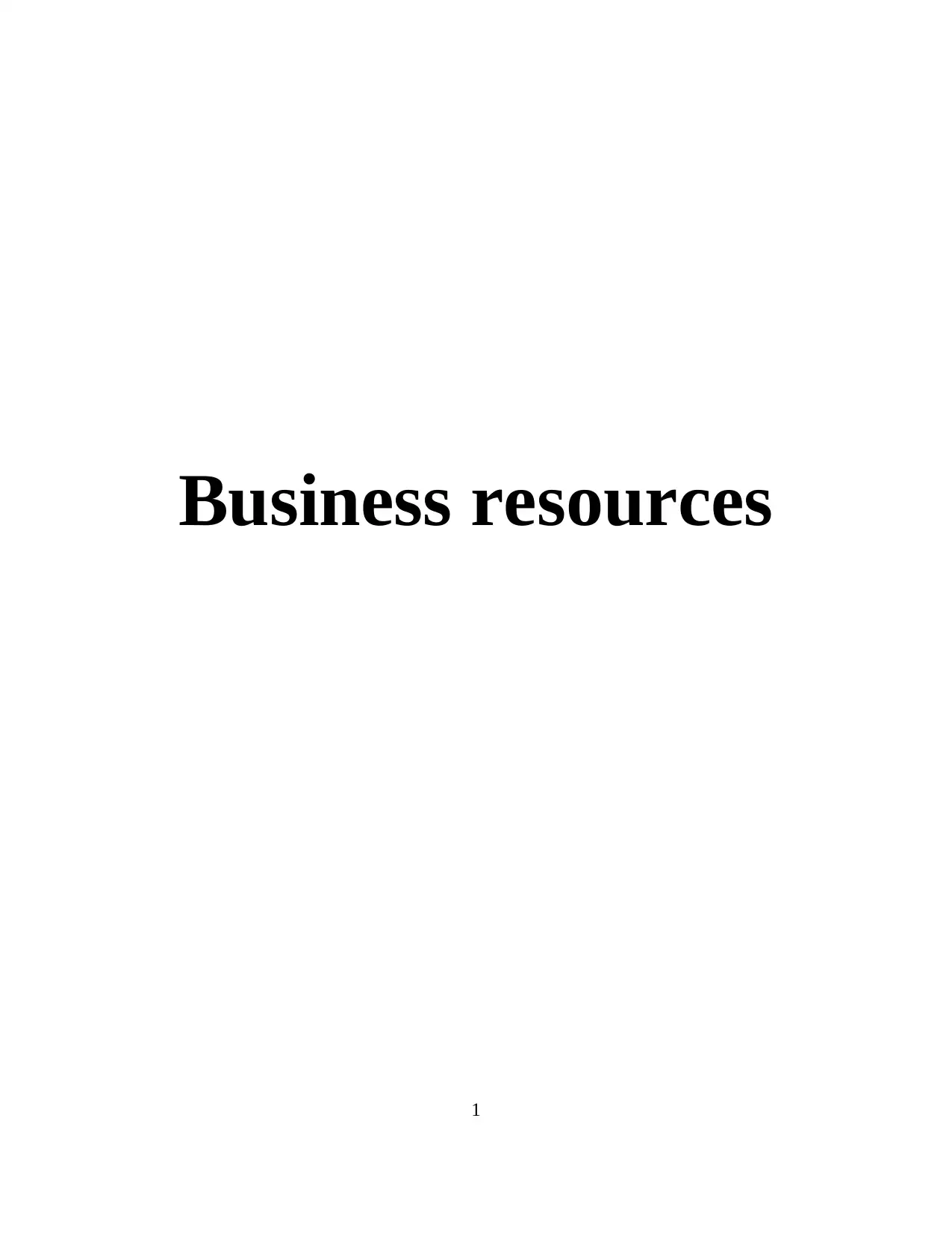
Business resources
1
1
Paraphrase This Document
Need a fresh take? Get an instant paraphrase of this document with our AI Paraphraser
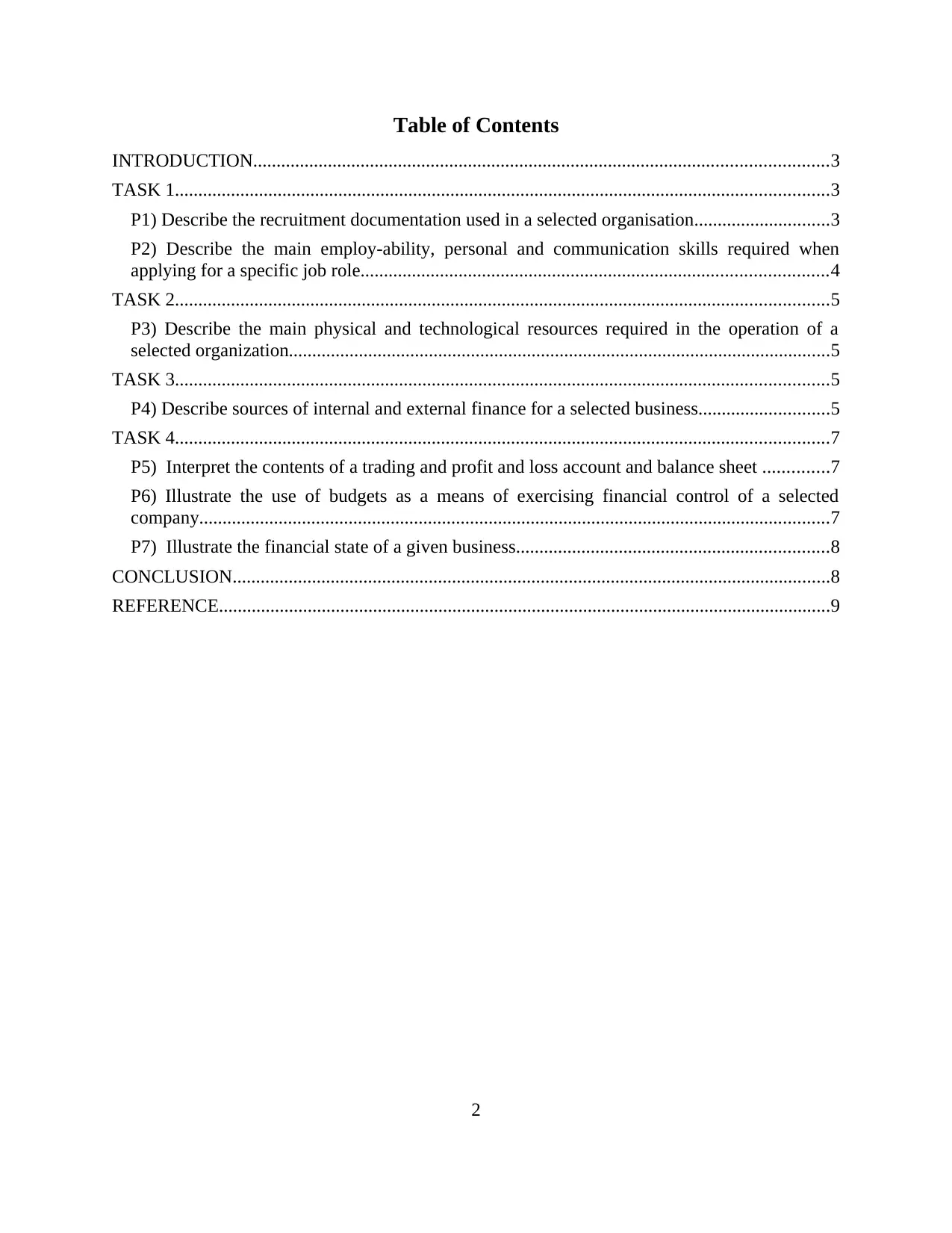
Table of Contents
INTRODUCTION...........................................................................................................................3
TASK 1............................................................................................................................................3
P1) Describe the recruitment documentation used in a selected organisation.............................3
P2) Describe the main employ-ability, personal and communication skills required when
applying for a specific job role....................................................................................................4
TASK 2............................................................................................................................................5
P3) Describe the main physical and technological resources required in the operation of a
selected organization....................................................................................................................5
TASK 3............................................................................................................................................5
P4) Describe sources of internal and external finance for a selected business............................5
TASK 4............................................................................................................................................7
P5) Interpret the contents of a trading and profit and loss account and balance sheet ..............7
P6) Illustrate the use of budgets as a means of exercising financial control of a selected
company.......................................................................................................................................7
P7) Illustrate the financial state of a given business...................................................................8
CONCLUSION................................................................................................................................8
REFERENCE...................................................................................................................................9
2
INTRODUCTION...........................................................................................................................3
TASK 1............................................................................................................................................3
P1) Describe the recruitment documentation used in a selected organisation.............................3
P2) Describe the main employ-ability, personal and communication skills required when
applying for a specific job role....................................................................................................4
TASK 2............................................................................................................................................5
P3) Describe the main physical and technological resources required in the operation of a
selected organization....................................................................................................................5
TASK 3............................................................................................................................................5
P4) Describe sources of internal and external finance for a selected business............................5
TASK 4............................................................................................................................................7
P5) Interpret the contents of a trading and profit and loss account and balance sheet ..............7
P6) Illustrate the use of budgets as a means of exercising financial control of a selected
company.......................................................................................................................................7
P7) Illustrate the financial state of a given business...................................................................8
CONCLUSION................................................................................................................................8
REFERENCE...................................................................................................................................9
2
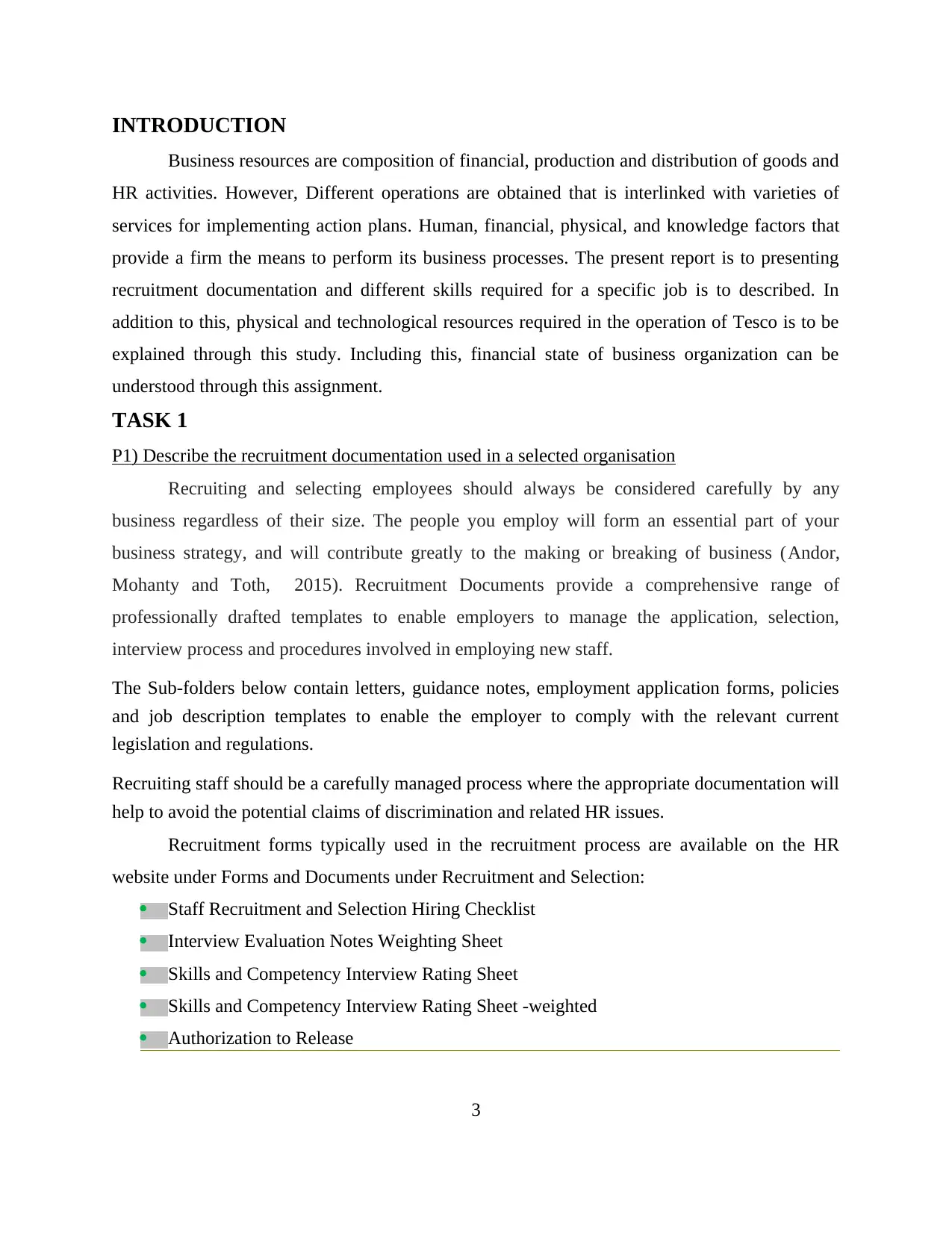
INTRODUCTION
Business resources are composition of financial, production and distribution of goods and
HR activities. However, Different operations are obtained that is interlinked with varieties of
services for implementing action plans. Human, financial, physical, and knowledge factors that
provide a firm the means to perform its business processes. The present report is to presenting
recruitment documentation and different skills required for a specific job is to described. In
addition to this, physical and technological resources required in the operation of Tesco is to be
explained through this study. Including this, financial state of business organization can be
understood through this assignment.
TASK 1
P1) Describe the recruitment documentation used in a selected organisation
Recruiting and selecting employees should always be considered carefully by any
business regardless of their size. The people you employ will form an essential part of your
business strategy, and will contribute greatly to the making or breaking of business (Andor,
Mohanty and Toth, 2015). Recruitment Documents provide a comprehensive range of
professionally drafted templates to enable employers to manage the application, selection,
interview process and procedures involved in employing new staff.
The Sub-folders below contain letters, guidance notes, employment application forms, policies
and job description templates to enable the employer to comply with the relevant current
legislation and regulations.
Recruiting staff should be a carefully managed process where the appropriate documentation will
help to avoid the potential claims of discrimination and related HR issues.
Recruitment forms typically used in the recruitment process are available on the HR
website under Forms and Documents under Recruitment and Selection:
Staff Recruitment and Selection Hiring Checklist
Interview Evaluation Notes Weighting Sheet
Skills and Competency Interview Rating Sheet
Skills and Competency Interview Rating Sheet -weighted
Authorization to Release
3
Business resources are composition of financial, production and distribution of goods and
HR activities. However, Different operations are obtained that is interlinked with varieties of
services for implementing action plans. Human, financial, physical, and knowledge factors that
provide a firm the means to perform its business processes. The present report is to presenting
recruitment documentation and different skills required for a specific job is to described. In
addition to this, physical and technological resources required in the operation of Tesco is to be
explained through this study. Including this, financial state of business organization can be
understood through this assignment.
TASK 1
P1) Describe the recruitment documentation used in a selected organisation
Recruiting and selecting employees should always be considered carefully by any
business regardless of their size. The people you employ will form an essential part of your
business strategy, and will contribute greatly to the making or breaking of business (Andor,
Mohanty and Toth, 2015). Recruitment Documents provide a comprehensive range of
professionally drafted templates to enable employers to manage the application, selection,
interview process and procedures involved in employing new staff.
The Sub-folders below contain letters, guidance notes, employment application forms, policies
and job description templates to enable the employer to comply with the relevant current
legislation and regulations.
Recruiting staff should be a carefully managed process where the appropriate documentation will
help to avoid the potential claims of discrimination and related HR issues.
Recruitment forms typically used in the recruitment process are available on the HR
website under Forms and Documents under Recruitment and Selection:
Staff Recruitment and Selection Hiring Checklist
Interview Evaluation Notes Weighting Sheet
Skills and Competency Interview Rating Sheet
Skills and Competency Interview Rating Sheet -weighted
Authorization to Release
3
⊘ This is a preview!⊘
Do you want full access?
Subscribe today to unlock all pages.

Trusted by 1+ million students worldwide
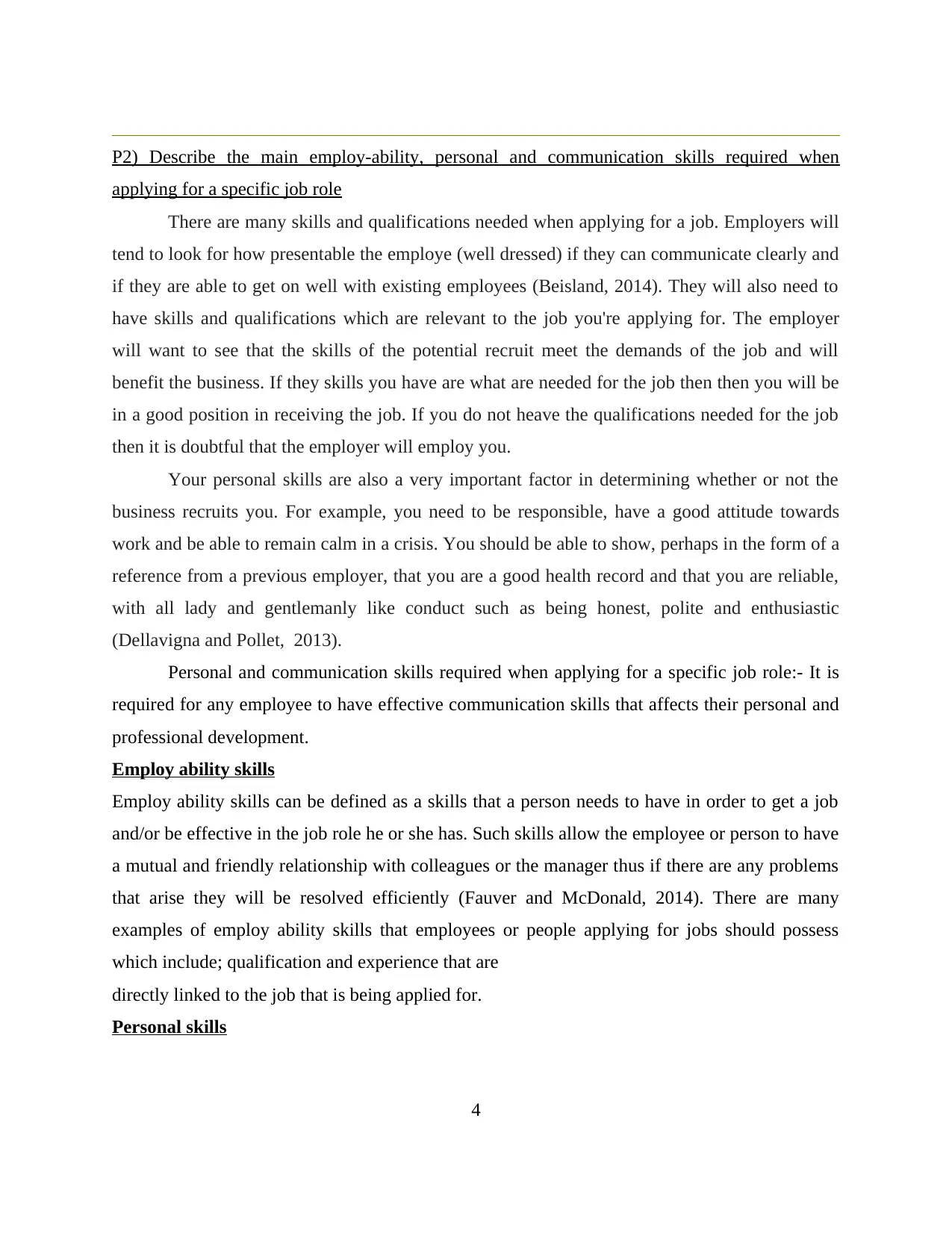
P2) Describe the main employ-ability, personal and communication skills required when
applying for a specific job role
There are many skills and qualifications needed when applying for a job. Employers will
tend to look for how presentable the employe (well dressed) if they can communicate clearly and
if they are able to get on well with existing employees (Beisland, 2014). They will also need to
have skills and qualifications which are relevant to the job you're applying for. The employer
will want to see that the skills of the potential recruit meet the demands of the job and will
benefit the business. If they skills you have are what are needed for the job then then you will be
in a good position in receiving the job. If you do not heave the qualifications needed for the job
then it is doubtful that the employer will employ you.
Your personal skills are also a very important factor in determining whether or not the
business recruits you. For example, you need to be responsible, have a good attitude towards
work and be able to remain calm in a crisis. You should be able to show, perhaps in the form of a
reference from a previous employer, that you are a good health record and that you are reliable,
with all lady and gentlemanly like conduct such as being honest, polite and enthusiastic
(Dellavigna and Pollet, 2013).
Personal and communication skills required when applying for a specific job role:- It is
required for any employee to have effective communication skills that affects their personal and
professional development.
Employ ability skills
Employ ability skills can be defined as a skills that a person needs to have in order to get a job
and/or be effective in the job role he or she has. Such skills allow the employee or person to have
a mutual and friendly relationship with colleagues or the manager thus if there are any problems
that arise they will be resolved efficiently (Fauver and McDonald, 2014). There are many
examples of employ ability skills that employees or people applying for jobs should possess
which include; qualification and experience that are
directly linked to the job that is being applied for.
Personal skills
4
applying for a specific job role
There are many skills and qualifications needed when applying for a job. Employers will
tend to look for how presentable the employe (well dressed) if they can communicate clearly and
if they are able to get on well with existing employees (Beisland, 2014). They will also need to
have skills and qualifications which are relevant to the job you're applying for. The employer
will want to see that the skills of the potential recruit meet the demands of the job and will
benefit the business. If they skills you have are what are needed for the job then then you will be
in a good position in receiving the job. If you do not heave the qualifications needed for the job
then it is doubtful that the employer will employ you.
Your personal skills are also a very important factor in determining whether or not the
business recruits you. For example, you need to be responsible, have a good attitude towards
work and be able to remain calm in a crisis. You should be able to show, perhaps in the form of a
reference from a previous employer, that you are a good health record and that you are reliable,
with all lady and gentlemanly like conduct such as being honest, polite and enthusiastic
(Dellavigna and Pollet, 2013).
Personal and communication skills required when applying for a specific job role:- It is
required for any employee to have effective communication skills that affects their personal and
professional development.
Employ ability skills
Employ ability skills can be defined as a skills that a person needs to have in order to get a job
and/or be effective in the job role he or she has. Such skills allow the employee or person to have
a mutual and friendly relationship with colleagues or the manager thus if there are any problems
that arise they will be resolved efficiently (Fauver and McDonald, 2014). There are many
examples of employ ability skills that employees or people applying for jobs should possess
which include; qualification and experience that are
directly linked to the job that is being applied for.
Personal skills
4
Paraphrase This Document
Need a fresh take? Get an instant paraphrase of this document with our AI Paraphraser
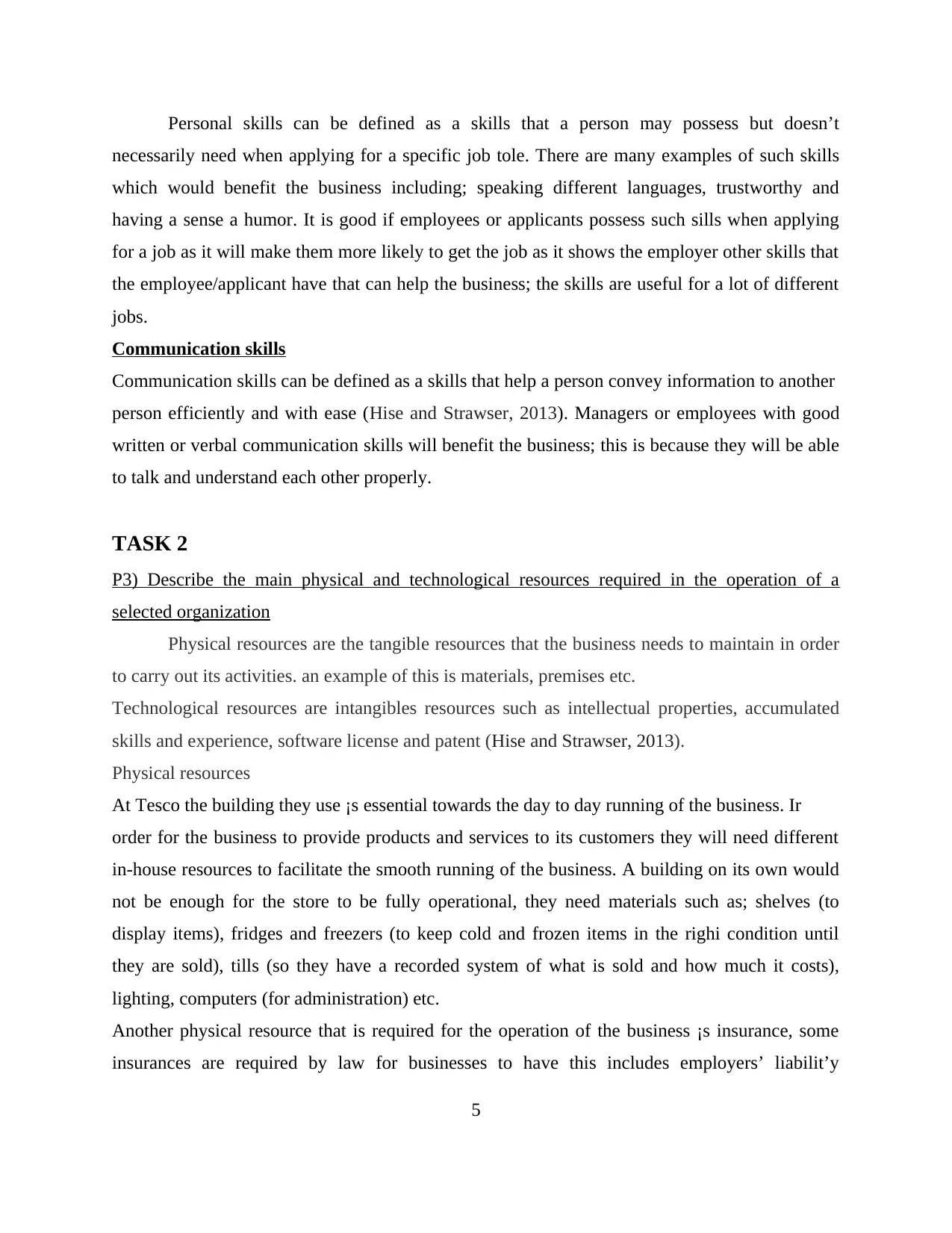
Personal skills can be defined as a skills that a person may possess but doesn’t
necessarily need when applying for a specific job tole. There are many examples of such skills
which would benefit the business including; speaking different languages, trustworthy and
having a sense a humor. It is good if employees or applicants possess such sills when applying
for a job as it will make them more likely to get the job as it shows the employer other skills that
the employee/applicant have that can help the business; the skills are useful for a lot of different
jobs.
Communication skills
Communication skills can be defined as a skills that help a person convey information to another
person efficiently and with ease (Hise and Strawser, 2013). Managers or employees with good
written or verbal communication skills will benefit the business; this is because they will be able
to talk and understand each other properly.
TASK 2
P3) Describe the main physical and technological resources required in the operation of a
selected organization
Physical resources are the tangible resources that the business needs to maintain in order
to carry out its activities. an example of this is materials, premises etc.
Technological resources are intangibles resources such as intellectual properties, accumulated
skills and experience, software license and patent (Hise and Strawser, 2013).
Physical resources
At Tesco the building they use ¡s essential towards the day to day running of the business. Ir
order for the business to provide products and services to its customers they will need different
in-house resources to facilitate the smooth running of the business. A building on its own would
not be enough for the store to be fully operational, they need materials such as; shelves (to
display items), fridges and freezers (to keep cold and frozen items in the righi condition until
they are sold), tills (so they have a recorded system of what is sold and how much it costs),
lighting, computers (for administration) etc.
Another physical resource that is required for the operation of the business ¡s insurance, some
insurances are required by law for businesses to have this includes employers’ liabilit’y
5
necessarily need when applying for a specific job tole. There are many examples of such skills
which would benefit the business including; speaking different languages, trustworthy and
having a sense a humor. It is good if employees or applicants possess such sills when applying
for a job as it will make them more likely to get the job as it shows the employer other skills that
the employee/applicant have that can help the business; the skills are useful for a lot of different
jobs.
Communication skills
Communication skills can be defined as a skills that help a person convey information to another
person efficiently and with ease (Hise and Strawser, 2013). Managers or employees with good
written or verbal communication skills will benefit the business; this is because they will be able
to talk and understand each other properly.
TASK 2
P3) Describe the main physical and technological resources required in the operation of a
selected organization
Physical resources are the tangible resources that the business needs to maintain in order
to carry out its activities. an example of this is materials, premises etc.
Technological resources are intangibles resources such as intellectual properties, accumulated
skills and experience, software license and patent (Hise and Strawser, 2013).
Physical resources
At Tesco the building they use ¡s essential towards the day to day running of the business. Ir
order for the business to provide products and services to its customers they will need different
in-house resources to facilitate the smooth running of the business. A building on its own would
not be enough for the store to be fully operational, they need materials such as; shelves (to
display items), fridges and freezers (to keep cold and frozen items in the righi condition until
they are sold), tills (so they have a recorded system of what is sold and how much it costs),
lighting, computers (for administration) etc.
Another physical resource that is required for the operation of the business ¡s insurance, some
insurances are required by law for businesses to have this includes employers’ liabilit’y
5
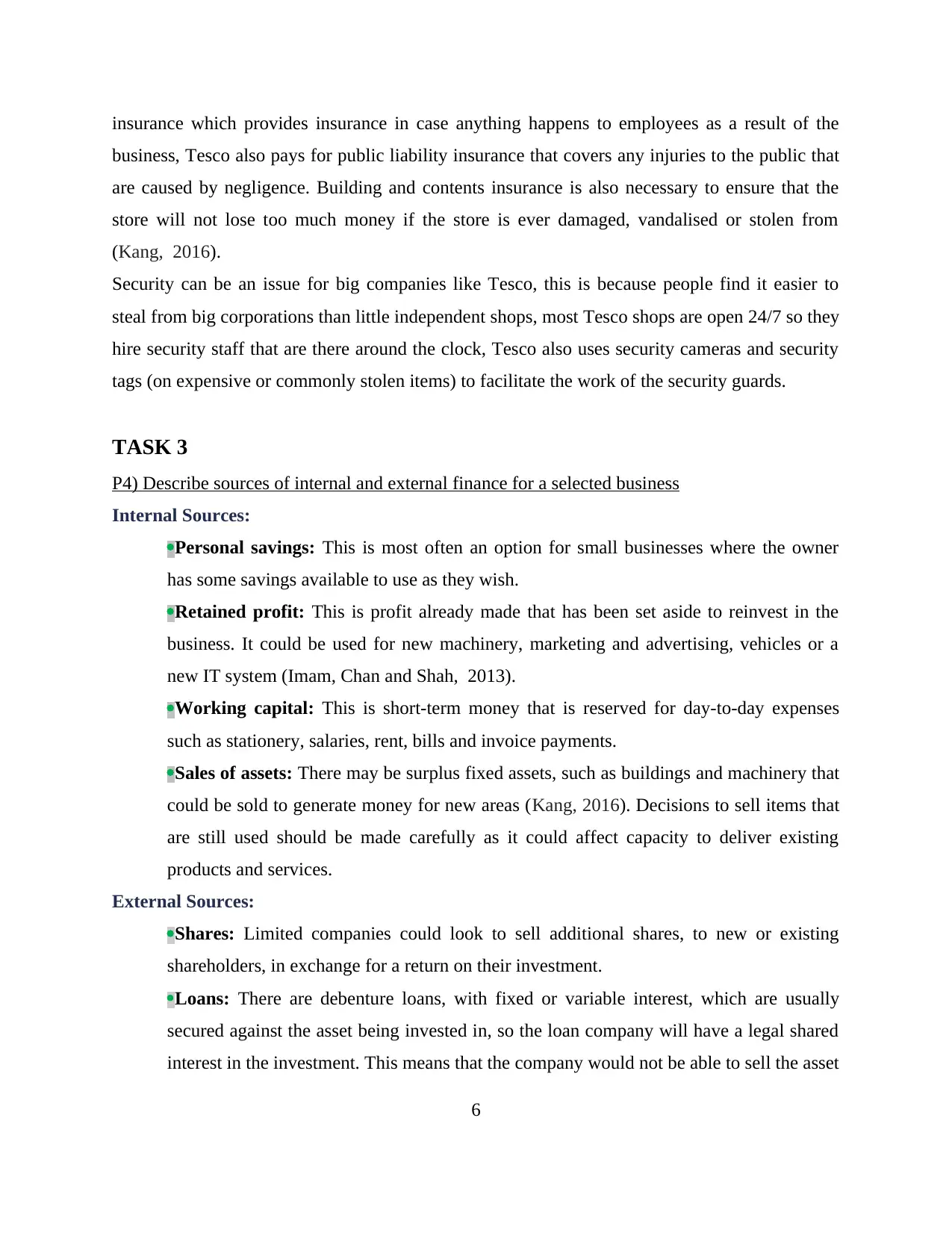
insurance which provides insurance in case anything happens to employees as a result of the
business, Tesco also pays for public liability insurance that covers any injuries to the public that
are caused by negligence. Building and contents insurance is also necessary to ensure that the
store will not lose too much money if the store is ever damaged, vandalised or stolen from
(Kang, 2016).
Security can be an issue for big companies like Tesco, this is because people find it easier to
steal from big corporations than little independent shops, most Tesco shops are open 24/7 so they
hire security staff that are there around the clock, Tesco also uses security cameras and security
tags (on expensive or commonly stolen items) to facilitate the work of the security guards.
TASK 3
P4) Describe sources of internal and external finance for a selected business
Internal Sources:
Personal savings: This is most often an option for small businesses where the owner
has some savings available to use as they wish.
Retained profit: This is profit already made that has been set aside to reinvest in the
business. It could be used for new machinery, marketing and advertising, vehicles or a
new IT system (Imam, Chan and Shah, 2013).
Working capital: This is short-term money that is reserved for day-to-day expenses
such as stationery, salaries, rent, bills and invoice payments.
Sales of assets: There may be surplus fixed assets, such as buildings and machinery that
could be sold to generate money for new areas (Kang, 2016). Decisions to sell items that
are still used should be made carefully as it could affect capacity to deliver existing
products and services.
External Sources:
Shares: Limited companies could look to sell additional shares, to new or existing
shareholders, in exchange for a return on their investment.
Loans: There are debenture loans, with fixed or variable interest, which are usually
secured against the asset being invested in, so the loan company will have a legal shared
interest in the investment. This means that the company would not be able to sell the asset
6
business, Tesco also pays for public liability insurance that covers any injuries to the public that
are caused by negligence. Building and contents insurance is also necessary to ensure that the
store will not lose too much money if the store is ever damaged, vandalised or stolen from
(Kang, 2016).
Security can be an issue for big companies like Tesco, this is because people find it easier to
steal from big corporations than little independent shops, most Tesco shops are open 24/7 so they
hire security staff that are there around the clock, Tesco also uses security cameras and security
tags (on expensive or commonly stolen items) to facilitate the work of the security guards.
TASK 3
P4) Describe sources of internal and external finance for a selected business
Internal Sources:
Personal savings: This is most often an option for small businesses where the owner
has some savings available to use as they wish.
Retained profit: This is profit already made that has been set aside to reinvest in the
business. It could be used for new machinery, marketing and advertising, vehicles or a
new IT system (Imam, Chan and Shah, 2013).
Working capital: This is short-term money that is reserved for day-to-day expenses
such as stationery, salaries, rent, bills and invoice payments.
Sales of assets: There may be surplus fixed assets, such as buildings and machinery that
could be sold to generate money for new areas (Kang, 2016). Decisions to sell items that
are still used should be made carefully as it could affect capacity to deliver existing
products and services.
External Sources:
Shares: Limited companies could look to sell additional shares, to new or existing
shareholders, in exchange for a return on their investment.
Loans: There are debenture loans, with fixed or variable interest, which are usually
secured against the asset being invested in, so the loan company will have a legal shared
interest in the investment. This means that the company would not be able to sell the asset
6
⊘ This is a preview!⊘
Do you want full access?
Subscribe today to unlock all pages.

Trusted by 1+ million students worldwide
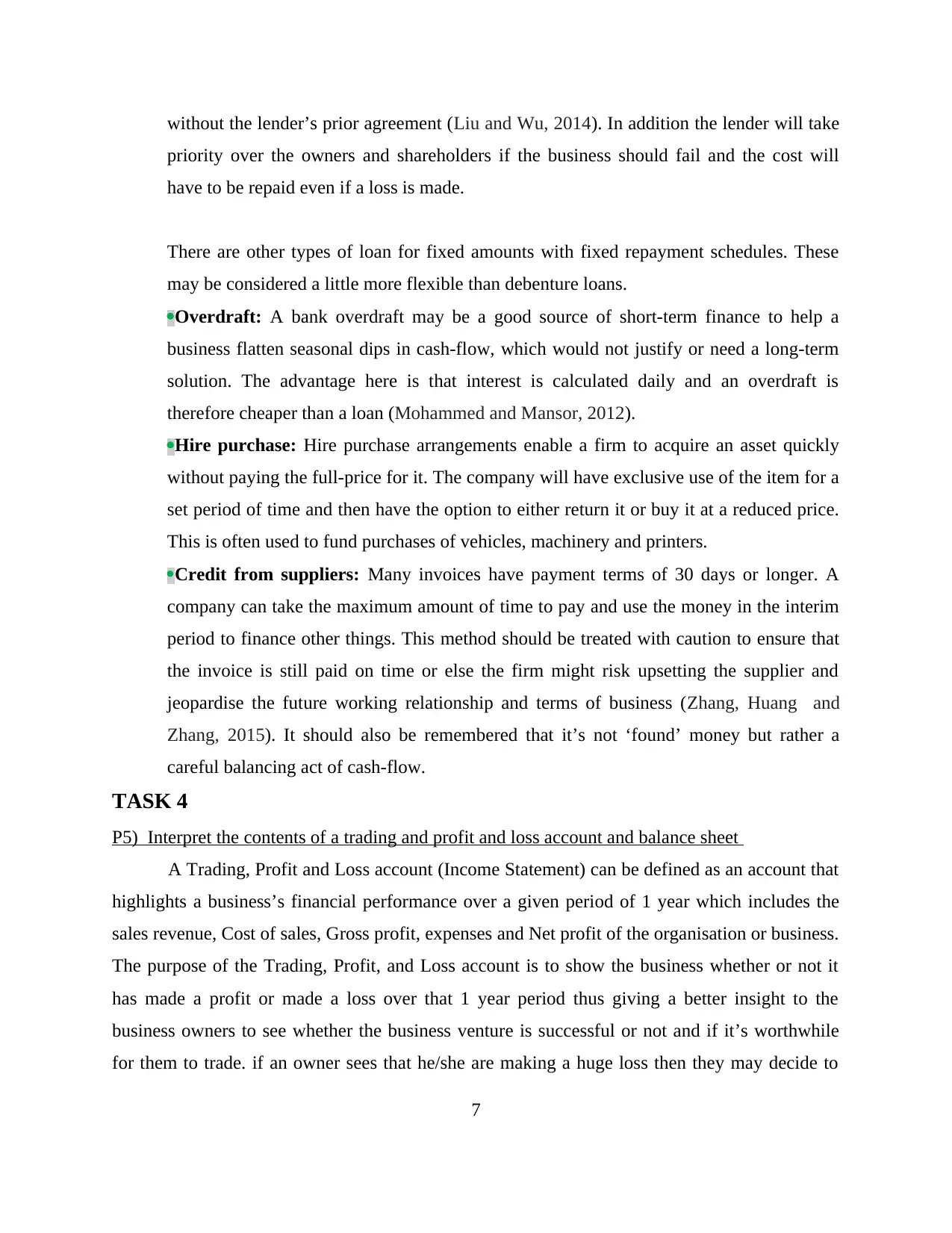
without the lender’s prior agreement (Liu and Wu, 2014). In addition the lender will take
priority over the owners and shareholders if the business should fail and the cost will
have to be repaid even if a loss is made.
There are other types of loan for fixed amounts with fixed repayment schedules. These
may be considered a little more flexible than debenture loans.
Overdraft: A bank overdraft may be a good source of short-term finance to help a
business flatten seasonal dips in cash-flow, which would not justify or need a long-term
solution. The advantage here is that interest is calculated daily and an overdraft is
therefore cheaper than a loan (Mohammed and Mansor, 2012).
Hire purchase: Hire purchase arrangements enable a firm to acquire an asset quickly
without paying the full-price for it. The company will have exclusive use of the item for a
set period of time and then have the option to either return it or buy it at a reduced price.
This is often used to fund purchases of vehicles, machinery and printers.
Credit from suppliers: Many invoices have payment terms of 30 days or longer. A
company can take the maximum amount of time to pay and use the money in the interim
period to finance other things. This method should be treated with caution to ensure that
the invoice is still paid on time or else the firm might risk upsetting the supplier and
jeopardise the future working relationship and terms of business (Zhang, Huang and
Zhang, 2015). It should also be remembered that it’s not ‘found’ money but rather a
careful balancing act of cash-flow.
TASK 4
P5) Interpret the contents of a trading and profit and loss account and balance sheet
A Trading, Profit and Loss account (Income Statement) can be defined as an account that
highlights a business’s financial performance over a given period of 1 year which includes the
sales revenue, Cost of sales, Gross profit, expenses and Net profit of the organisation or business.
The purpose of the Trading, Profit, and Loss account is to show the business whether or not it
has made a profit or made a loss over that 1 year period thus giving a better insight to the
business owners to see whether the business venture is successful or not and if it’s worthwhile
for them to trade. if an owner sees that he/she are making a huge loss then they may decide to
7
priority over the owners and shareholders if the business should fail and the cost will
have to be repaid even if a loss is made.
There are other types of loan for fixed amounts with fixed repayment schedules. These
may be considered a little more flexible than debenture loans.
Overdraft: A bank overdraft may be a good source of short-term finance to help a
business flatten seasonal dips in cash-flow, which would not justify or need a long-term
solution. The advantage here is that interest is calculated daily and an overdraft is
therefore cheaper than a loan (Mohammed and Mansor, 2012).
Hire purchase: Hire purchase arrangements enable a firm to acquire an asset quickly
without paying the full-price for it. The company will have exclusive use of the item for a
set period of time and then have the option to either return it or buy it at a reduced price.
This is often used to fund purchases of vehicles, machinery and printers.
Credit from suppliers: Many invoices have payment terms of 30 days or longer. A
company can take the maximum amount of time to pay and use the money in the interim
period to finance other things. This method should be treated with caution to ensure that
the invoice is still paid on time or else the firm might risk upsetting the supplier and
jeopardise the future working relationship and terms of business (Zhang, Huang and
Zhang, 2015). It should also be remembered that it’s not ‘found’ money but rather a
careful balancing act of cash-flow.
TASK 4
P5) Interpret the contents of a trading and profit and loss account and balance sheet
A Trading, Profit and Loss account (Income Statement) can be defined as an account that
highlights a business’s financial performance over a given period of 1 year which includes the
sales revenue, Cost of sales, Gross profit, expenses and Net profit of the organisation or business.
The purpose of the Trading, Profit, and Loss account is to show the business whether or not it
has made a profit or made a loss over that 1 year period thus giving a better insight to the
business owners to see whether the business venture is successful or not and if it’s worthwhile
for them to trade. if an owner sees that he/she are making a huge loss then they may decide to
7
Paraphrase This Document
Need a fresh take? Get an instant paraphrase of this document with our AI Paraphraser
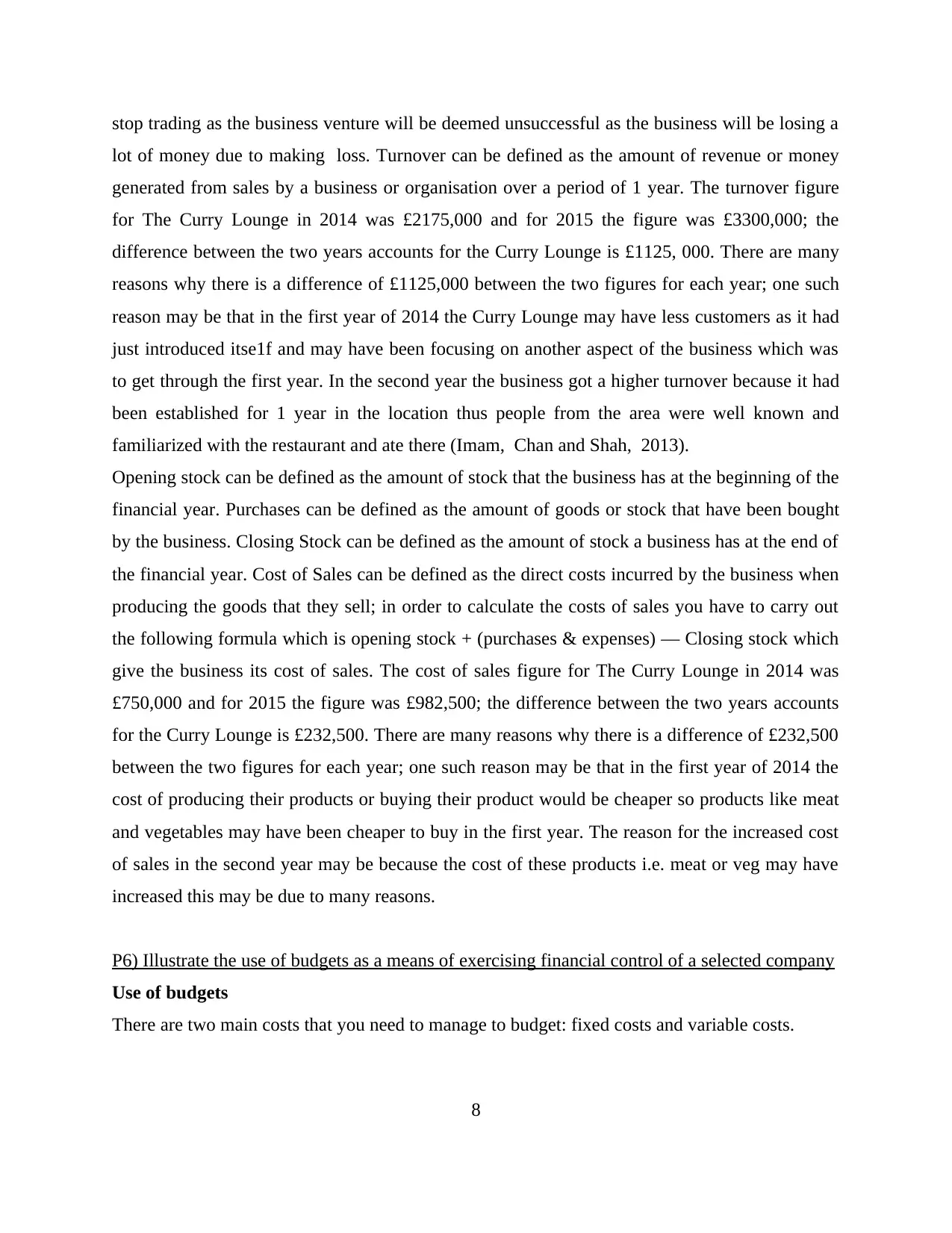
stop trading as the business venture will be deemed unsuccessful as the business will be losing a
lot of money due to making loss. Turnover can be defined as the amount of revenue or money
generated from sales by a business or organisation over a period of 1 year. The turnover figure
for The Curry Lounge in 2014 was £2175,000 and for 2015 the figure was £3300,000; the
difference between the two years accounts for the Curry Lounge is £1125, 000. There are many
reasons why there is a difference of £1125,000 between the two figures for each year; one such
reason may be that in the first year of 2014 the Curry Lounge may have less customers as it had
just introduced itse1f and may have been focusing on another aspect of the business which was
to get through the first year. In the second year the business got a higher turnover because it had
been established for 1 year in the location thus people from the area were well known and
familiarized with the restaurant and ate there (Imam, Chan and Shah, 2013).
Opening stock can be defined as the amount of stock that the business has at the beginning of the
financial year. Purchases can be defined as the amount of goods or stock that have been bought
by the business. Closing Stock can be defined as the amount of stock a business has at the end of
the financial year. Cost of Sales can be defined as the direct costs incurred by the business when
producing the goods that they sell; in order to calculate the costs of sales you have to carry out
the following formula which is opening stock + (purchases & expenses) — Closing stock which
give the business its cost of sales. The cost of sales figure for The Curry Lounge in 2014 was
£750,000 and for 2015 the figure was £982,500; the difference between the two years accounts
for the Curry Lounge is £232,500. There are many reasons why there is a difference of £232,500
between the two figures for each year; one such reason may be that in the first year of 2014 the
cost of producing their products or buying their product would be cheaper so products like meat
and vegetables may have been cheaper to buy in the first year. The reason for the increased cost
of sales in the second year may be because the cost of these products i.e. meat or veg may have
increased this may be due to many reasons.
P6) Illustrate the use of budgets as a means of exercising financial control of a selected company
Use of budgets
There are two main costs that you need to manage to budget: fixed costs and variable costs.
8
lot of money due to making loss. Turnover can be defined as the amount of revenue or money
generated from sales by a business or organisation over a period of 1 year. The turnover figure
for The Curry Lounge in 2014 was £2175,000 and for 2015 the figure was £3300,000; the
difference between the two years accounts for the Curry Lounge is £1125, 000. There are many
reasons why there is a difference of £1125,000 between the two figures for each year; one such
reason may be that in the first year of 2014 the Curry Lounge may have less customers as it had
just introduced itse1f and may have been focusing on another aspect of the business which was
to get through the first year. In the second year the business got a higher turnover because it had
been established for 1 year in the location thus people from the area were well known and
familiarized with the restaurant and ate there (Imam, Chan and Shah, 2013).
Opening stock can be defined as the amount of stock that the business has at the beginning of the
financial year. Purchases can be defined as the amount of goods or stock that have been bought
by the business. Closing Stock can be defined as the amount of stock a business has at the end of
the financial year. Cost of Sales can be defined as the direct costs incurred by the business when
producing the goods that they sell; in order to calculate the costs of sales you have to carry out
the following formula which is opening stock + (purchases & expenses) — Closing stock which
give the business its cost of sales. The cost of sales figure for The Curry Lounge in 2014 was
£750,000 and for 2015 the figure was £982,500; the difference between the two years accounts
for the Curry Lounge is £232,500. There are many reasons why there is a difference of £232,500
between the two figures for each year; one such reason may be that in the first year of 2014 the
cost of producing their products or buying their product would be cheaper so products like meat
and vegetables may have been cheaper to buy in the first year. The reason for the increased cost
of sales in the second year may be because the cost of these products i.e. meat or veg may have
increased this may be due to many reasons.
P6) Illustrate the use of budgets as a means of exercising financial control of a selected company
Use of budgets
There are two main costs that you need to manage to budget: fixed costs and variable costs.
8
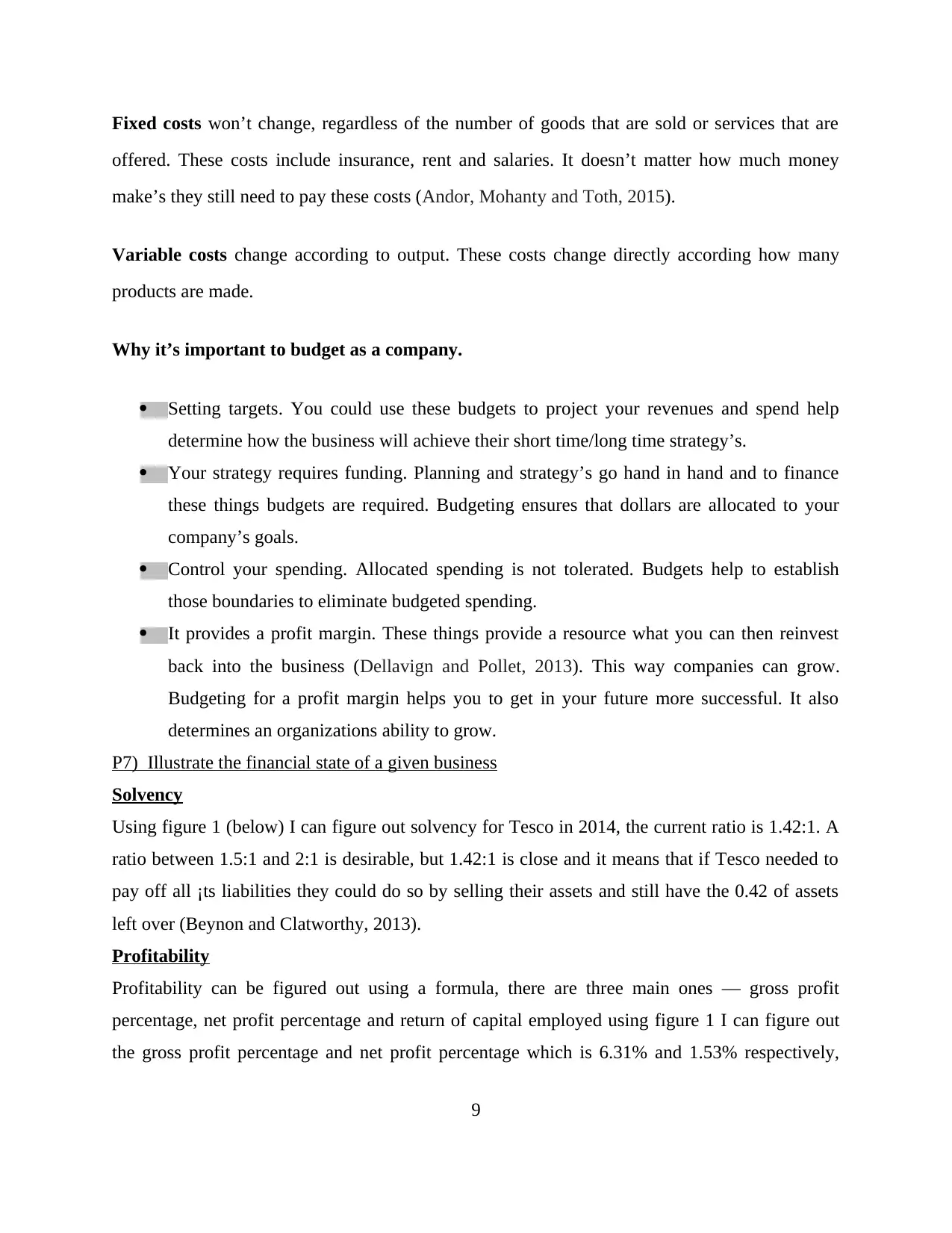
Fixed costs won’t change, regardless of the number of goods that are sold or services that are
offered. These costs include insurance, rent and salaries. It doesn’t matter how much money
make’s they still need to pay these costs (Andor, Mohanty and Toth, 2015).
Variable costs change according to output. These costs change directly according how many
products are made.
Why it’s important to budget as a company.
Setting targets. You could use these budgets to project your revenues and spend help
determine how the business will achieve their short time/long time strategy’s.
Your strategy requires funding. Planning and strategy’s go hand in hand and to finance
these things budgets are required. Budgeting ensures that dollars are allocated to your
company’s goals.
Control your spending. Allocated spending is not tolerated. Budgets help to establish
those boundaries to eliminate budgeted spending.
It provides a profit margin. These things provide a resource what you can then reinvest
back into the business (Dellavign and Pollet, 2013). This way companies can grow.
Budgeting for a profit margin helps you to get in your future more successful. It also
determines an organizations ability to grow.
P7) Illustrate the financial state of a given business
Solvency
Using figure 1 (below) I can figure out solvency for Tesco in 2014, the current ratio is 1.42:1. A
ratio between 1.5:1 and 2:1 is desirable, but 1.42:1 is close and it means that if Tesco needed to
pay off all ¡ts liabilities they could do so by selling their assets and still have the 0.42 of assets
left over (Beynon and Clatworthy, 2013).
Profitability
Profitability can be figured out using a formula, there are three main ones — gross profit
percentage, net profit percentage and return of capital employed using figure 1 I can figure out
the gross profit percentage and net profit percentage which is 6.31% and 1.53% respectively,
9
offered. These costs include insurance, rent and salaries. It doesn’t matter how much money
make’s they still need to pay these costs (Andor, Mohanty and Toth, 2015).
Variable costs change according to output. These costs change directly according how many
products are made.
Why it’s important to budget as a company.
Setting targets. You could use these budgets to project your revenues and spend help
determine how the business will achieve their short time/long time strategy’s.
Your strategy requires funding. Planning and strategy’s go hand in hand and to finance
these things budgets are required. Budgeting ensures that dollars are allocated to your
company’s goals.
Control your spending. Allocated spending is not tolerated. Budgets help to establish
those boundaries to eliminate budgeted spending.
It provides a profit margin. These things provide a resource what you can then reinvest
back into the business (Dellavign and Pollet, 2013). This way companies can grow.
Budgeting for a profit margin helps you to get in your future more successful. It also
determines an organizations ability to grow.
P7) Illustrate the financial state of a given business
Solvency
Using figure 1 (below) I can figure out solvency for Tesco in 2014, the current ratio is 1.42:1. A
ratio between 1.5:1 and 2:1 is desirable, but 1.42:1 is close and it means that if Tesco needed to
pay off all ¡ts liabilities they could do so by selling their assets and still have the 0.42 of assets
left over (Beynon and Clatworthy, 2013).
Profitability
Profitability can be figured out using a formula, there are three main ones — gross profit
percentage, net profit percentage and return of capital employed using figure 1 I can figure out
the gross profit percentage and net profit percentage which is 6.31% and 1.53% respectively,
9
⊘ This is a preview!⊘
Do you want full access?
Subscribe today to unlock all pages.

Trusted by 1+ million students worldwide
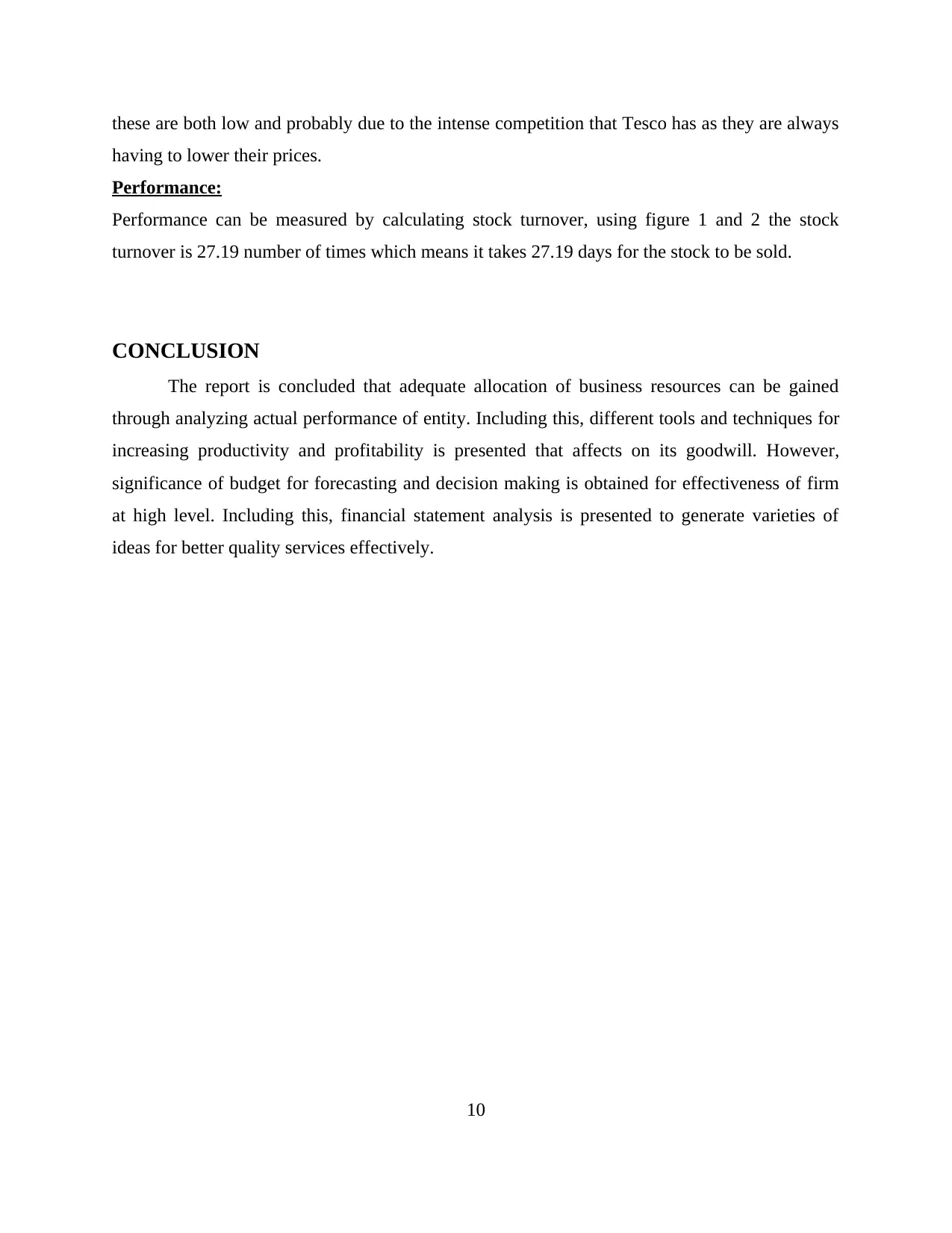
these are both low and probably due to the intense competition that Tesco has as they are always
having to lower their prices.
Performance:
Performance can be measured by calculating stock turnover, using figure 1 and 2 the stock
turnover is 27.19 number of times which means it takes 27.19 days for the stock to be sold.
CONCLUSION
The report is concluded that adequate allocation of business resources can be gained
through analyzing actual performance of entity. Including this, different tools and techniques for
increasing productivity and profitability is presented that affects on its goodwill. However,
significance of budget for forecasting and decision making is obtained for effectiveness of firm
at high level. Including this, financial statement analysis is presented to generate varieties of
ideas for better quality services effectively.
10
having to lower their prices.
Performance:
Performance can be measured by calculating stock turnover, using figure 1 and 2 the stock
turnover is 27.19 number of times which means it takes 27.19 days for the stock to be sold.
CONCLUSION
The report is concluded that adequate allocation of business resources can be gained
through analyzing actual performance of entity. Including this, different tools and techniques for
increasing productivity and profitability is presented that affects on its goodwill. However,
significance of budget for forecasting and decision making is obtained for effectiveness of firm
at high level. Including this, financial statement analysis is presented to generate varieties of
ideas for better quality services effectively.
10
Paraphrase This Document
Need a fresh take? Get an instant paraphrase of this document with our AI Paraphraser
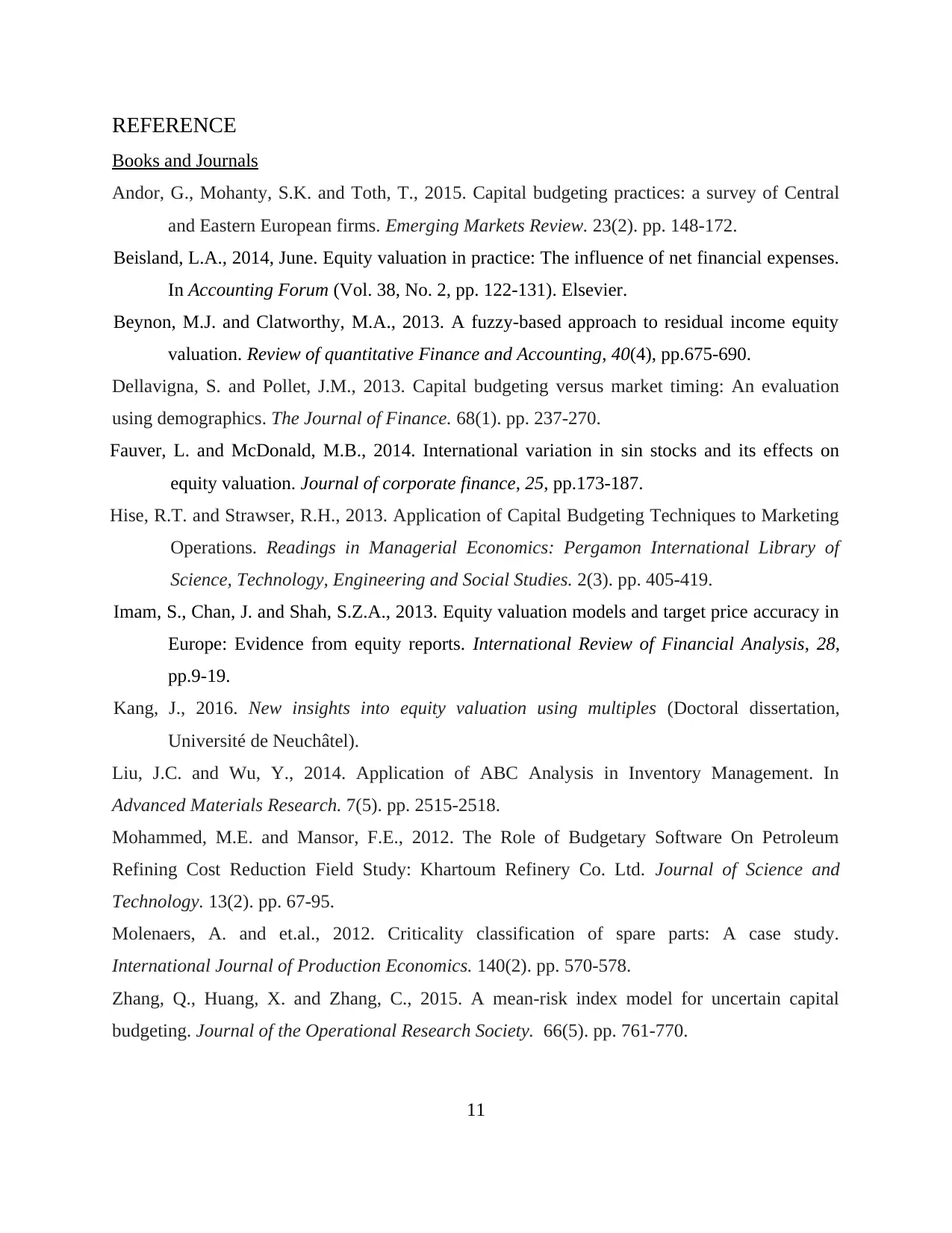
REFERENCE
Books and Journals
Andor, G., Mohanty, S.K. and Toth, T., 2015. Capital budgeting practices: a survey of Central
and Eastern European firms. Emerging Markets Review. 23(2). pp. 148-172.
Beisland, L.A., 2014, June. Equity valuation in practice: The influence of net financial expenses.
In Accounting Forum (Vol. 38, No. 2, pp. 122-131). Elsevier.
Beynon, M.J. and Clatworthy, M.A., 2013. A fuzzy-based approach to residual income equity
valuation. Review of quantitative Finance and Accounting, 40(4), pp.675-690.
Dellavigna, S. and Pollet, J.M., 2013. Capital budgeting versus market timing: An evaluation
using demographics. The Journal of Finance. 68(1). pp. 237-270.
Fauver, L. and McDonald, M.B., 2014. International variation in sin stocks and its effects on
equity valuation. Journal of corporate finance, 25, pp.173-187.
Hise, R.T. and Strawser, R.H., 2013. Application of Capital Budgeting Techniques to Marketing
Operations. Readings in Managerial Economics: Pergamon International Library of
Science, Technology, Engineering and Social Studies. 2(3). pp. 405-419.
Imam, S., Chan, J. and Shah, S.Z.A., 2013. Equity valuation models and target price accuracy in
Europe: Evidence from equity reports. International Review of Financial Analysis, 28,
pp.9-19.
Kang, J., 2016. New insights into equity valuation using multiples (Doctoral dissertation,
Université de Neuchâtel).
Liu, J.C. and Wu, Y., 2014. Application of ABC Analysis in Inventory Management. In
Advanced Materials Research. 7(5). pp. 2515-2518.
Mohammed, M.E. and Mansor, F.E., 2012. The Role of Budgetary Software On Petroleum
Refining Cost Reduction Field Study: Khartoum Refinery Co. Ltd. Journal of Science and
Technology. 13(2). pp. 67-95.
Molenaers, A. and et.al., 2012. Criticality classification of spare parts: A case study.
International Journal of Production Economics. 140(2). pp. 570-578.
Zhang, Q., Huang, X. and Zhang, C., 2015. A mean-risk index model for uncertain capital
budgeting. Journal of the Operational Research Society. 66(5). pp. 761-770.
11
Books and Journals
Andor, G., Mohanty, S.K. and Toth, T., 2015. Capital budgeting practices: a survey of Central
and Eastern European firms. Emerging Markets Review. 23(2). pp. 148-172.
Beisland, L.A., 2014, June. Equity valuation in practice: The influence of net financial expenses.
In Accounting Forum (Vol. 38, No. 2, pp. 122-131). Elsevier.
Beynon, M.J. and Clatworthy, M.A., 2013. A fuzzy-based approach to residual income equity
valuation. Review of quantitative Finance and Accounting, 40(4), pp.675-690.
Dellavigna, S. and Pollet, J.M., 2013. Capital budgeting versus market timing: An evaluation
using demographics. The Journal of Finance. 68(1). pp. 237-270.
Fauver, L. and McDonald, M.B., 2014. International variation in sin stocks and its effects on
equity valuation. Journal of corporate finance, 25, pp.173-187.
Hise, R.T. and Strawser, R.H., 2013. Application of Capital Budgeting Techniques to Marketing
Operations. Readings in Managerial Economics: Pergamon International Library of
Science, Technology, Engineering and Social Studies. 2(3). pp. 405-419.
Imam, S., Chan, J. and Shah, S.Z.A., 2013. Equity valuation models and target price accuracy in
Europe: Evidence from equity reports. International Review of Financial Analysis, 28,
pp.9-19.
Kang, J., 2016. New insights into equity valuation using multiples (Doctoral dissertation,
Université de Neuchâtel).
Liu, J.C. and Wu, Y., 2014. Application of ABC Analysis in Inventory Management. In
Advanced Materials Research. 7(5). pp. 2515-2518.
Mohammed, M.E. and Mansor, F.E., 2012. The Role of Budgetary Software On Petroleum
Refining Cost Reduction Field Study: Khartoum Refinery Co. Ltd. Journal of Science and
Technology. 13(2). pp. 67-95.
Molenaers, A. and et.al., 2012. Criticality classification of spare parts: A case study.
International Journal of Production Economics. 140(2). pp. 570-578.
Zhang, Q., Huang, X. and Zhang, C., 2015. A mean-risk index model for uncertain capital
budgeting. Journal of the Operational Research Society. 66(5). pp. 761-770.
11
1 out of 11
Related Documents
Your All-in-One AI-Powered Toolkit for Academic Success.
+13062052269
info@desklib.com
Available 24*7 on WhatsApp / Email
![[object Object]](/_next/static/media/star-bottom.7253800d.svg)
Unlock your academic potential
Copyright © 2020–2025 A2Z Services. All Rights Reserved. Developed and managed by ZUCOL.





